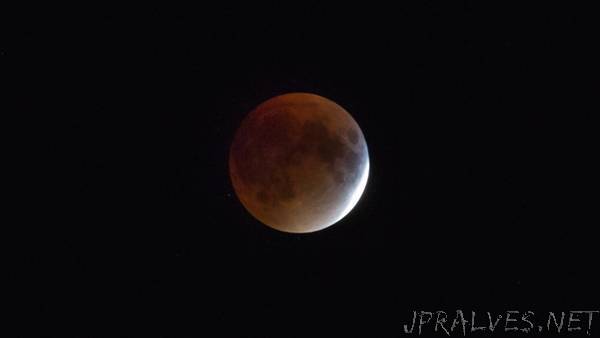
“The cosmos offers an early morning trifecta for the world’s skygazers Wednesday: a super blue blood moon.
That’s quite a mouthful, so let’s briefly break down what it all means:
It is a supermoon because it will turn full at the closest point to Earth in its orbit, known as perigee, appearing slightly bigger and about 14 percent brighter than normal. Perigee will occur Tuesday, the day before full moon, when our planet and the moon will be 223,068 miles apart. Supermoons are fairly common, on average happening about every 14 months. This one to end January is actually the third in a row, following supermoons on Jan. 1 and Dec. 3, 2017.
It is a blue moon because it is the second full moon occurring within the same month. The moon won’t actually turn the color blue. The relative infrequency of two moons occurring in the same month, about once every 2.7 years, is behind the saying “once in a blue moon.”
It is a blood moon because it will pass through the Earth’s shadow, resulting in a total lunar eclipse in some areas, and will turn a red-copper or “bloody” hue.
The last time we had an eclipse on the second full Moon of a calendar month in the Americas was in late March 1866, more than 150 years ago.
Of these three lunar events, the eclipse is the most visually interesting, but residents in the eastern United States, including Washington, will see only a very faint and partial view. The Western states, Alaska and Hawaii will enjoy more of a spectacle.
“The further west you go, you’ll get a better view,” said U.S. Naval Observatory astronomer Geoff Chester.
East Coast gazers can see the moon glide into the Earth’s penumbral shadow (the outer rim of the shadow) by looking west at 6:15 a.m. The moon will darken subtly, then begin to cross the umbral shadow at 6:48 a.m., darkening more, but the moon will be a whisker above the western horizon, setting at 7:15 a.m. It will not turn red.
Out west, skygazers will be able to see the whole eclipse — red tint and all. The middle of the eclipse is at 6:30 a.m. Mountain time, 5:30 a.m. Pacific time.
Wednesday’s blue moon is the first of two this calendar year. March also will feature two full moons during its 31 days, but there will be no full moon in February. The last time we had two blue moons in the same year was in 1999, also during January and March.
Alexander Brown offered a lyrical description of the 1866 eclipse, observing from Arbroath, Scotland, north of St. Andrews, on the North Sea.
“For hours previous to the entrance of the moon into the earth’s dark shadow, not a cloud covered the face of the sky; and Luna was beheld pouring her mild radiance on field and town, path and moor,” wrote Brown, a weaver by trade and insatiable scholar, in the Intellectual Observer, a scientific magazine.
“When the entire disc, at forty-four minutes past three, had passed into the shadow, the eclipsed moon became distinctly visible, showing a gradation of tints from blue to green on the outside, to a gradually increasing red, which further on changed to a color resembling that of incandescent iron when at a dull-red heat,” he wrote.
We only have to wait 19 years for the next trifecta super blue blood moon, Chester said. The next total lunar eclipse on the second full moon of a calendar month will be Jan. 31, 2037, at 9:06 a.m. Eastern time. “This one actually occurs closer to perigee than the one coming up,” said Chester. That perigee will be Feb. 1, 2037, about 16 hours after the full moon, with 222,199 miles between Earth and the moon.
“Once again, this is the second-closest perigee for the year,” he said.
The next blue moon and total lunar eclipse that is not super will occur Dec. 31, 2028.
Eclipses occur in 18-year cycles called saros. This upcoming eclipse is lunar eclipse saros 124, which stretches from the years 1152 to 2450. In this series, the total eclipses occur every 18 years from June 25, 1657, to April 7, 2144.
The astronomy webcaster Slooh.com will follow the lunar eclipse from western North America, Hawaii, Australia and Asia on Jan. 31, starting at 7 a.m.
The Griffith Observatory in Los Angeles will host a public viewing event from 3:45 to 7 a.m., Pacific time. The observatory offers free admission to this event, and it will stream it online starting at 2:45 a.m. Pacific time.”
